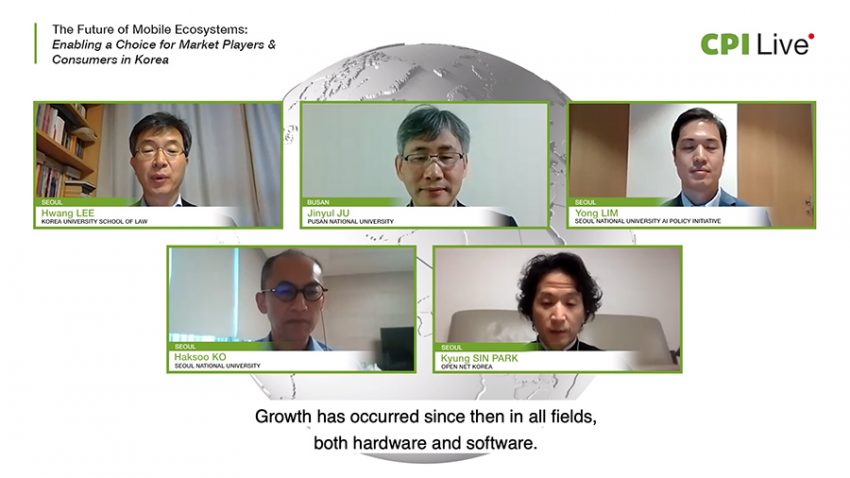Online Advertising, Market Competition, Data and Transparency: Opportunities & Challenges for the Ads Ecosystem in Japan (Program Synthesis)
BACKGROUND NOTE:
- September 2019: Japanese Government established “Headquarters for Digital Market Competition” to – an organization comprised of experts with diverse and high-level knowledge in order to address the issues in the digital markets, including the ones caused by digital platforms.
- February, 2020: Bill on Improving Transparency and Fairness of Specified Digital Platforms was introduced that specifically targets online malls and app stores.
Panel Summary
The Panel was moderated by Daniel Sokol (University of Florida) who noted that technological innovation or disruption limits the competition concerns arising from much demonized network effects. He also urged the Panel to reflect on the interplay of privacy concerns, digital advertising and competition law.
While Daisuke Korenaga (Tokyo Metropolitan University) gave a glimpse of the competition regulation landscape in Japan and briefly highlighted the different legislations that have been mooted in context of digital platforms, Prof. Renato Nazzini (King’s College London) discussed the developments in the EU and the UK in relation to regulation of digital platforms and noted how the UK approach is sounder and based on economic evidence, compared to the European approach. Daisuke Korenaga also made observations regarding differences between the Japanese approach (based on self-review and self-reporting) to transparency and the European approach (more rigorous and stricter). Prof. Renato Nazzini also highlighted the key role that institutional design plays in outcomes of competition policy.
Both, Kensuke Kubo and Prof. Renato Nazzini noted that indirect network effects are not per se anticompetitive and are a feature of the multisided markets. Kensuke Kubo noted while JFTC does not have significant experience in analysis of indirect network effects, JFTC could employ simulations for the analysis.
Takako Onoki (White & Case) highlighted the role that industry bodies such as the American Chamber of Commerce in Japan could play in channeling views of the stakeholders to the relevant authorities. She made pertinent remarks on the need to respect the freedom of consumers who make calculated calls while divulging information to different platforms. She highlighted the need to balance innovation with regulation, a sentiment that was shared by Prof. Renato Nazzini who also highlighted the consumer welfare that the digital platforms generate. He also highlighted the need for collaborative regulation, introducing measures regarding data portability and data sharing in the digital platform space.

Key Talking Points | Kensuke Kubo
- Vertical Integration:
Traditional advertising industry was vertically integrated in that ad agencies directly connected advertisers with publishers just as Google does now.
Google and Facebook have connected the two different sides of the market, through acquisitions and organic growth, thus unlocking efficiencies such as elimination of double margin, facilitation of investments, better sharing of information, etc.
On the flipside, there are customer foreclosure effects and input foreclosure effects of vertical integration. One needs to examine if the advantages enjoyed by vertically integrated firms, are on account of efficiency or alleged anti-competitive conduct.
- Indirect Network Effects:
Indirect Network Effects are not per se anti-competitive:
Indirect Network Effects are a feature of double-sided markets, generate a lot of efficiencies and it would be incorrect to assume anti-competitive impacts of network effects. While indirect network may generate consumer surplus, all else equal, they also predispose a market towards tipping. Once a player is entrenched, and has attained a certain scale, new entrants may find it hard to enter markets.
Impact on pricing:
(a) Indirect network effects may lead to pricing peculiarities such as zero pricing for one side of users and the issue of fair compensation. Illustratively, some Japanese news publishers have claimed that their share of ad revenues is actually too low relative to what they would expect in a competitive market.
(b) To address the issue of fair compensation, there are proposals requiring digital platforms to disclose the revenue from each advertiser for each advertisement so that the publishers can enter into negotiations with the digital platforms with more information than they currently have. The efficacy of such proposal remains to be seen.
- Other Remarks:
It remains to be seen whether self-preferencing by digital platforms actually occurs or not.
It needs to be understood if tech companies have a duty to deal (a corollary of essential facilities doctrine) with counterparties.
JFTC does not have great experience in handling network effects and needs to be cautious in doing so. Using economic models to conduct simulation (not just simple demand estimation, or simple surveys of consumers) would be a good idea to analyse network effects.
It may be a good idea to introduce greater transparency in relation to the ad revenues.
“…there are also other questions about whether if there are certain advantages enjoyed by vertically integrated firms, that’s because of efficiency or if it’s because of any alleged anti-competitive conduct…” – Kensuke Kubo

Key Talking Points | Daisuke Korenaga
- Japanese Developments:
New Digital Platform legislation of Japan aims to maintain and promote competition and innovation and is premised on the belief that overregulation is problematic.
Headquarters of Digital Market Competition set up under the auspices of the Minister of economy, trade and industry, general agency) to device policies for the digital markets. JFTC continues to be pivotal in sphere of competition issues.
- Key difficulties of the Anti-Monopoly Law:
(i) Difficulty in defining the relevant market;
(ii) Difficulty in evaluating competition in the relevant market; and
(iii) The fact that investigation takes time (even as JFTC is one of the fastest amongst the advanced countries).
To overcome these difficulties, anti-monopolistic actions can be checked in advance, acts that aid consumer choice can be promoted, and switching cost for users can be lowered.
- Japanese model versus the EU model
Unlike the EU that has a wider ambit, Japanese law on improving transparency and fairness on digital platforms is restricted to only large online mall and App store. Another point of departure from the European counterpart is that the system of monitoring review is based on self-review by the targeted operators, that are then reviewed by the Ministry of Economy, Trade and Industry. This is a collaborative process.
- On data sharing
Data sharing should be promoted, while being mindful that data sharing can lead to misuse / cartelization.
“…On digital platform, downstream market can be operated for free. Zero-price market is because of the effect of network effect. Network can effect on not two-side effect but multi-side, it is the issue of economies of scale and scope…”- Daisuke Korenaga

Key Talking Points | Takako Onoki
- On regulation:
Innovation and regulation both are important. There is a need to promote companies’ efforts and self-imposed regulation since the industry is highly dynamic and there is lag effect that regulators face.
- Role of trade associations in policy consultations: Industries can use trade associations such as the American Chamber of Commerce in Japan (ACCJ) to relay their suggestions to the JFTC. Illustratively, ACCJ submitted public comments on the “Guidelines Concerning Abuse of a Superior Bargaining Position in Transaction between Digital Platform Operators and Consumers that Provide Personal Information, etc.”.
- On Privacy: Consumers as rational actors provide information to the platforms. If consumer has adequate privacy controls on the information, there are no competition concerns per se.
“…consumers provide some privacy information to digital platform, and consumers receive services… I have choice whether or not to provide or I decide not to use that platform if I think it’s not reasonable…” – Takako Onoki

Key Talking Points | Prof. Renato Nazzini
- On UK & EU Experience:
The Competition and Markets Authority in the UK published in July, 2020 a major report on digital advertising. According to this report, while there is some evidence of harm and market power in these markets, there is also finding that Google’s intermediation fees are in line with the fees charged by or other intermediaries.
CMA makes certain drastic recommendations and divestiture of erring firms is not advisable. Any competition concerns arising in relation to digital platforms can be sufficiently addressed by the existing competition tool kits.
(i) European Commission, on the back of weak economic evidence, has mooted a new marketing investigation tool that could facilitate imposition of behavior or structural remedies. Google Search, AdSense cases show that competition law can deal with contractual and softer kind of indirect exclusivity type restrictions.
“…Sometimes it is said, well is European Union or European Commission always finding or investigating US platforms for abuse of dominance and so on and so forth? Do they have anything against US? No, the sad reality is there are no EU platforms to investigate…” – Prof. Nazzini
- On Data:
Digital platforms increase consumer welfare greatly. Any data protection regime should be mindful of this, based on hard evidence and be shorn of political motivations.
Collaborative regulation involving governments and institutional organizations, such as the Asia Pacific Economic Corporation Group (recognized in the Mexico, Canada, US agreement of 2019) may be a good option.
There are inevitable overlaps in data privacy and competition issues. Privacy laws should not be overly restrictive (like the GDPR). Data portability and data sharing (possibly on anonymized basis, with user consent by public entities) should be encouraged with adequate safeguards.
- On Institutional Design: The antitrust policies and regulations should be guided by economic evidence and not political motivations. This should reflect in institutional design as well.
- On Network Effects: They are not a competition problem per se and are a feature of many platforms and they are a feature of online advertising as well.
“…one should be very well cautious against and about the risk of regulatory fragmentation worldwide…”– Prof. Nazzini
Featured News
Dutch Regulator Fines Uber €10 Million for Privacy Violations
Jan 31, 2024 by
CPI
DOJ Investigates AI Competition, Eyes Microsoft’s OpenAI Deal: Bloomberg
Jan 31, 2024 by
CPI
Japanese Regulator Approves Korean Air’s Merger with Asiana Airlines
Jan 31, 2024 by
CPI
Netgear Files Antitrust Lawsuit Against Huawei Alleging Patent Misuse
Jan 31, 2024 by
CPI
Tennessee and Virginia Attorneys General Challenge NCAA’s NIL Rules in Federal Lawsuit
Jan 31, 2024 by
CPI
Antitrust Mix by CPI
Antitrust Chronicle® – The Rule(s) of Reason
Jan 29, 2024 by
CPI
Evolving the Rule of Reason for Legacy Business Conduct
Jan 29, 2024 by
CPI
The Object Identity
Jan 29, 2024 by
CPI
In Praise of Rules-Based Antitrust
Jan 29, 2024 by
CPI
The Future of State AG Antitrust Enforcement and Federal-State Cooperation
Jan 29, 2024 by
CPI
